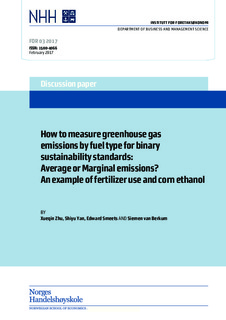| dc.description.abstract | This study proposed a modelling framework which addresses various issues such as decreasing marginal yield of corn with respect to fertilizer use in biofuel production and the resulting greenhouse gas emissions. Particularly, the framework considered exogenous changes including oil price development and biofuel policy through market interactions of different inputs and outputs in biofuel production. We applied the modelling framework numerically in an example of corn ethanol production in the United States to illustrate how the economics of fertilizer use could impact the GHG emissions based on both average and marginal emissions. The results show that higher oil prices increase the prices of gasoline, natural gas, ethanol, and corn, which stimulates corn-based ethanol production and increases corn yields by encouraging profit-maximizing farmers to increase their application rate of nitrogen fertilizers slightly. The effect is that, on average, GHG emissions per unit of produced corn ethanol remain almost constant if oil price increases from 60 to 120 $/barrel.
However, the marginal emissions per additional unit of ethanol production increase by 2.2% or10%, depending on whether the Volumetric Ethanol Excise Tax Credit is implemented or not. More important is that the marginal emissions of corn ethanol are much higher than those of conventional gasoline. Although on average there are GHG emission savings of corn ethanol compared to conventional gasoline, the savings are negative when based on the marginal emissions of corn ethanol. An interesting implication is that the effectiveness of biofuel policies aimed at reducing GHG emissions might be questionable. | nb_NO |
